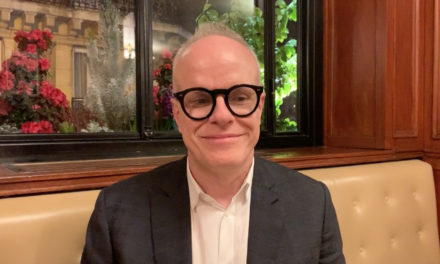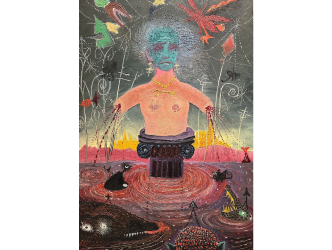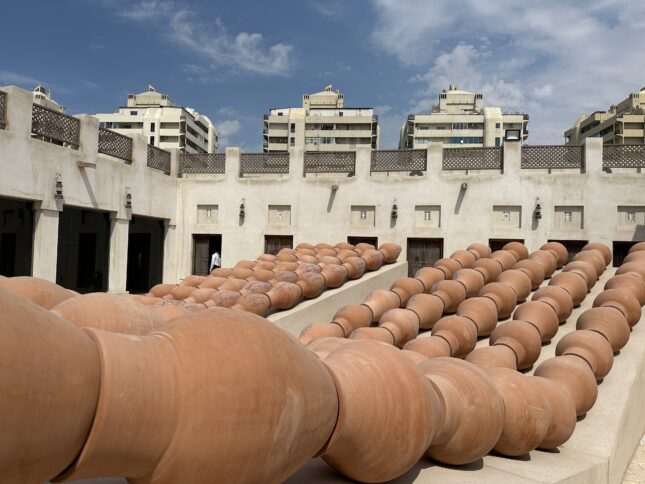
Carolina Caycedo
Global South
If anyone mentions Sharjah, the contemporary art fans say: that’s where the Biennial is. People generally don’t know much about this emirate, which is part of the UAE, apart from the fact that it is wedged between the riches of Abu Dhabi with its sumptuous Louvre and the commercial effervescence of Dubai. Sharjah has found its cultural identity by specializing in expressions of the avant-garde from the “Global South”, to use the term currently in vogue. It is here, for example, that I saw in 2021 the first and excellent retrospective of Baya, the unique Algerian painter, long before the retrospective at the Institut du Monde Arabe (Arab World Institute) in Paris which ended in March 2023.
Hoor Al Quasimi
In February 2023 the fifteenth Sharjah Biennial opened. I visited shortly after the opening. Hoor Al Qasimi, the director and daughter of the local Emir was there, bright and early, ultra involved, making sure everything was running smoothly, surrounded by her beloved cats. I took the opportunity to interview her before even visiting the Biennial. To my surprise, she spoke to me about the sites rather than the art shown at these sites. I would come to understand why later. She started with a historic viewpoint:
Thinking historically

Yinka Shonibare
“I took over the Biennial 20 years ago. As an artist growing up in Sharjah it was really an important platform for me. I could see how it was inspiring for me in the 80s and I know what the possibilities are for the future generations. Now I can see a big difference. The title this year, ‘Thinking historically in the present’, was suggested by Okwui Enwezor (1). He wanted to do an historic show including new commissions. This biennial was postponed by two years because it was an important edition. Everybody was going through so much during the pandemic, so I thought that a lot of people talk about care but not many people practice it. It was important to slow down and just do what had to be done.”
Taking time
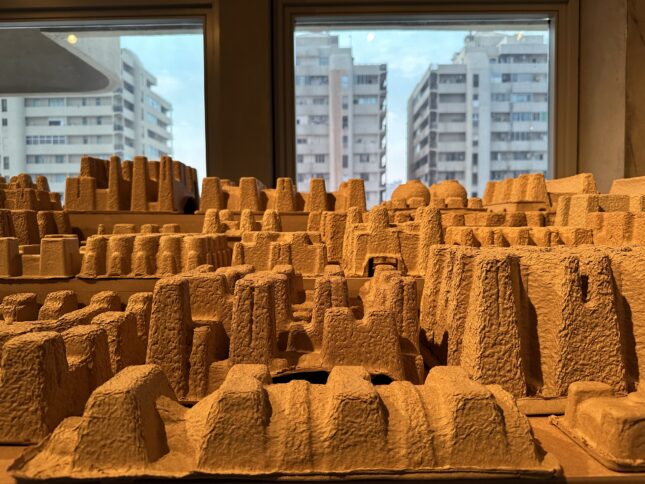
Kader Attia
When addressing the issue of content, Hoor replies as though in a reflection on the post-covid era:
“This biennial is not about rushing around. It’s about taking time. For the occasion we have restored numerous sites. There are a lot of films and a lot of spaces for contemplation. You need at least 4 days to see it properly. One week would be better.” In fact, the Sharjah Biennial is colossal this year. It is taking place across 19 sites spread across five cities of the Emirates with a maximum distance of two hours by car.
Inventory of world futures
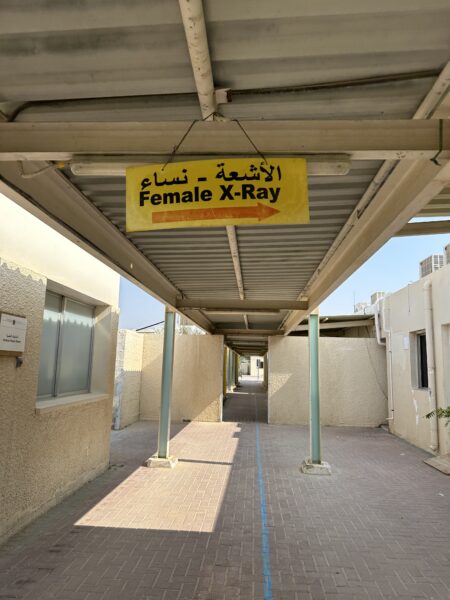
Al Dhaid, Sharjah Biennial
150 artists are exhibited in the historic city centre of Sharjah but also in a former school, at a former courthouse and even in a disused medical clinic almost in the middle of the desert. In fact this colossal biennial is, as Okwui Enwezor said about “his” Venice Biennale in 2015, a kind of inventory of “world futures”. In other words, it presents other ways of seeing, with a perspective that no longer takes the rich West and its history as the standard epicentres.
Doris Salcedo
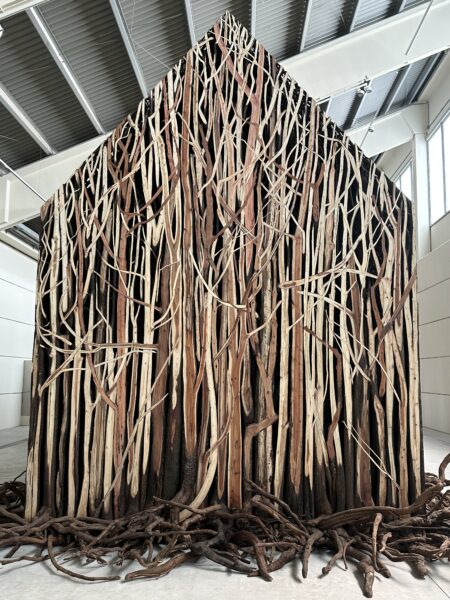
Doris Salcedo
You have to work for it: the most captivating artwork at the Sharjah Biennial can be found in Kalba, right at the other end of the country, right by the Fujairah emirate on the Gulf of Oman, 114 kilometres from the capital. In a former ice factory, Columbian artist Doris Salcedo has created a monumental installation named “Uprooted”. 804 dead trees were modelled and assembled to create a structure that takes the form of a house that is uninhabitable. This is because the trees that make up this construction are all barriers that prevent anyone from entering. A reference to the status of homeless migrants and refugees. An ambivalent artwork that evokes beauty at first glance while expressing a kind of passive-aggressive quality. You could also read it as an environmental message…

Doris Salcedo
Kerry James Marshall
Without doubt the most disappointing installation is located at the Old Al-Diwan Al-Amiri. Here, the giant of American painting Kerry James Marshall – I want to stress that for me he is a major artist who I usually admire, particularly for his genre scenes from contemporary Africa American life – has made an artwork that is barely comprehensible. The visitor first sees a bridge, and beneath it there is an unfinished image composed of painted squares. It’s a fake version of an old archaeological site. But the execution doesn’t allow us to understand this unless we read it in the Biennial’s guide book.
Of Men and Gods and Muds
The Biennial has also selected works seen elsewhere, which at Sharjah take on quite a particular flavour. This is true of the film by Lebanese artist Ali Cherri, “Of Men and Gods and Mud” from 2022, also screened at the 2022 Venice Biennale, which tells the story of a worker in a brickyard on the banks of the Nile. Sublime landscapes, men of sculptural beauty, dreams and utopias but also immense solitude and terrible working and living conditions. A version for cinemas was recently released around the world ( See here the report about the movie).
Philippe Parreno
This is also the case for a work by French artist Philippe Parreno, located in Kalba in a courtyard in the heart of a kindergarten. It’s a three-legged machine called a Heliotrope, which follows the movements of the sun. This sophisticated moving architecture was previously exhibited at the Bourse de Commerce, Pinault Collection in Paris (See here the report about this exhibition).
Isaac Julien
One of the most striking filmic installations at the Sharjah Biennial can be found in the centre of the city, made by British artist Isaac Julien in 2022, entitled “Once Again (Statues Never Die)”. A group of giant double-sided screens fill the space and recount the treatment of ancient African statues which in the early 20th century were placed in museums of ethnology, whereas the Greek or Egyptian statues (although the latter were also African) were exhibited in art museums.

Isaac Julien
Its narrative takes the form of an imaginary dialogue between two men of the art world, which also references an anti-colonialist short film by filmmakers Alain Resnais and Chris Marker from 1953, “Les statues meurent aussi” (Statues Also Die). The short film, which was censured for a long time, starts by saying: “When men die they go down in history. When statues die they go down in art. This botany of death is what we call culture.” (Once Again… (Statues Never Die) is also shown in the retrospective dedicated to Isaac Julien at Tate Britain from 25 April).
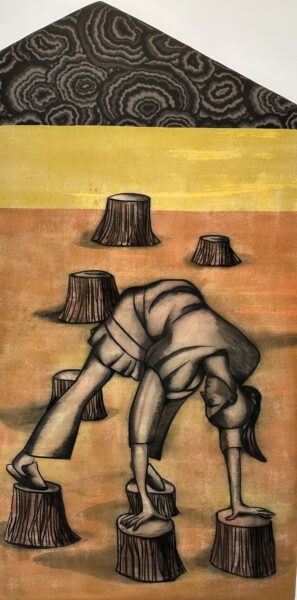
Anju Dodiya
An excellent introduction to the Sharjah Biennial, whose central subject involves revisiting the history of art and its more recent history in the light of new principles that are emerging everywhere and helping to see the world in another way, such as through the lens of postcolonialism.
Until 11 June. https://sharjahart.org/biennial-15
Donating=Supporting

Support independent news on art.
Your contribution : Make a monthly commitment to support JB Reports or a one off contribution as and when you feel like it. Choose the option that suits you best.
Need to cancel a recurring donation? Please go here.
The donation is considered to be a subscription for a fee set by the donor and for a duration also set by the donor.



